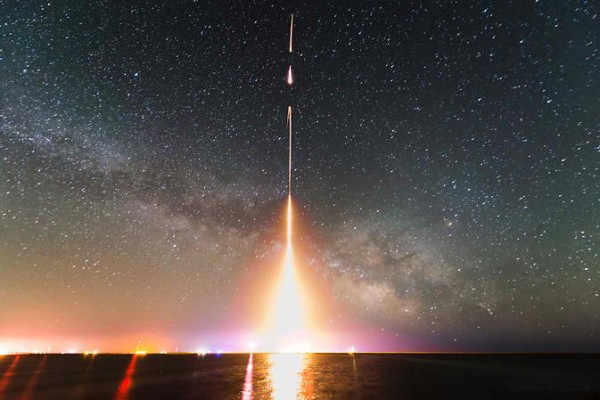Half of the Universe's Stars are Hidden in Dark Spaces Between Galaxies
| Ana Verayo | | Nov 07, 2014 02:50 AM EST |
(Photo : NASA/T. Arai/University of Tokyo) The Cosmic Infrared Background Experiment (CIBER) rocket launch from NASA's Wallops Flight Facility in Virginia in 2013.
CalTech (California Institute of Technology) researchers have revealed there's more cosmic light from the universe than that emitted by known galaxies based on an experiment aboard one of NASA's suborbital rockets.
Researchers believe there are star systems in the spaces among galaxies that appear dark in radars. Those dark spaces, however, can actually contain faint light from weaker stars. These weak stars were violently ejected from their home galaxies and hurled into the outskirts of space.
Like Us on Facebook
Researchers also estimate that almost half the stars in the universe are "orphan" stars that don't belong to any galaxy. This orphaning process might have occurred when two galaxies collide. When the merging occurs, these weaker stars are thrown out into the cosmos and billions of stars have been this way ever since.
Harvey Moseley, a NASA astrophysicist, said if this theory is proven correct, there might be an entire population of stars that are just out there waiting to be discovered. Since each individual star is so faint, however, scientists can only observe them in clusters.
This faint background light was picked up by NASA's Spitzer Space Telescope. The Caltech team later sent the CIBER (Cosmic Infrared Background ExpeRiment) up in space to further observe these weak stars closer.
Earlier theories suggest these light signals are remnants from early galaxies formed during the Big Bang. Using a highly sensitive light meter via infrared, CIBER acquired readings from light emanating from the universe.
This study will be published on November 7 in the journal, Science.
TagsHalf of the Universe's Stars are Hidden in Dark Spaces Between Galaxies, NASA, caltech, CIBER, orphan stars, nasa background light galaxies stars
©2015 Chinatopix All rights reserved. Do not reproduce without permission
EDITOR'S PICKS
-

Did the Trump administration just announce plans for a trade war with ‘hostile’ China and Russia?
-

US Senate passes Taiwan travel bill slammed by China
-

As Yan Sihong’s family grieves, here are other Chinese students who went missing abroad. Some have never been found
-

Beijing blasts Western critics who ‘smear China’ with the term sharp power
-

China Envoy Seeks to Defuse Tensions With U.S. as a Trade War Brews
-

Singapore's Deputy PM Provides Bitcoin Vote of Confidence Amid China's Blanket Bans
-

China warns investors over risks in overseas virtual currency trading
-

Chinese government most trustworthy: survey
-

Kashima Antlers On Course For Back-To-Back Titles
MOST POPULAR
LATEST NEWS
Zhou Yongkang: China's Former Security Chief Sentenced to Life in Prison

China's former Chief of the Ministry of Public Security, Zhou Yongkang, has been given a life sentence after he was found guilty of abusing his office, bribery and deliberately ... Full Article
TRENDING STORY

China Pork Prices Expected to Stabilize As The Supplies Recover

Elephone P9000 Smartphone is now on Sale on Amazon India

There's a Big Chance Cliffhangers Won't Still Be Resolved When Grey's Anatomy Season 13 Returns

Supreme Court Ruled on Samsung vs Apple Dispute for Patent Infringement

Microsoft Surface Pro 5 Rumors and Release Date: What is the Latest?










